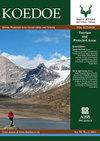Assessing the effect of tagging and the vulnerability to predation in tigerfish (Hydrocynus vittatus, Castelnau 1861) in a water-stressed system using telemetry methods
IF 1.1
4区 环境科学与生态学
Q3 BIODIVERSITY CONSERVATION
引用次数: 6
Abstract
Fish are well established around the world as indicators of ecological integrity (Harrison & Whitfield 2006; Mims & Olden 2013; Sosa-López et al. 2005). Similar to other aquatic organisms, fish species face several challenges from the environment they occur in and are subject to a plethora of stressors, both natural and anthropogenic (Du Plessis 2019; O’Brien et al. 2018). The ever-increasing anthropogenic pressures have generally led to a steady decline in aquatic organisms, including fish species (Dudgeon 2014; Rodell et al. 2018). Fish kills and population declines are often reported worldwide as a result of deteriorating aquatic ecosystems (Ferreira & Pienaar 2011; Thronson & Quigg 2008). This deterioration has been attributed to several factors, including river fragmentation, flow modification, pollution, the introduction of alien species and global climate change (De Moor 1996; Ellender & Weyl 2014; O’Brien et al. 2019). Fish make use of the available physical habitat as refugia, for feeding and spawning, and as nurseries for their offspring (Godin 1997; O’Brien et al. 2013). Maintaining these environments is essential, but they are often inaccessible and difficult to sample, making observations hard to Increase in anthropogenic pressures on freshwater ecosystems, globally and locally in South Africa, has made it difficult to meet environmental flow requirements and maintain these systems. The Letaba-Olifants catchment is one such example, where the upstream water demands place pressure on the river downstream as it flows through the Kruger National Park. We used the activity rates of Hydrocynus vittatus as a line of evidence to assess (1) the effects of telemeter tagging on their activity rates in three potential post-tagging recovery periods and (2) their vulnerability to predation and the causality related to the environmental stressors placed on the river catchment in the Olifants River Gorge, Kruger National Park, South Africa. We determined H. vittatus activity rates as locomotive movement using radio telemetry methods linked remotely to an online data management system. We telemeter tagged nine individuals from 08 May to 28 June 2018. However, only seven fish were successfully tracked for the duration of our study, and two individuals moved out of range of the remote network shortly after release and could not be located. The tagged H. vittatus individuals were found to have reduced activity at least within the first 7 days after tagging compared with the time after that. The results showed that three individuals were preyed on by predators after the tagging procedure recovery period. This coincided with abnormal low flow conditions, where the Letaba River ran dry. African fish eagles Haliaeestus vocifer were the only confirmed predator, whilst predation by other species was also evident.利用遥测方法评估缺水系统中虎鱼(Hydrocynus vittatus, Castelnau 1861)的标记效果和对捕食的脆弱性
鱼类在世界各地被公认为生态完整性的指标(Harrison & Whitfield 2006;mim & Olden 2013;Sosa-López et al. 2005)。与其他水生生物类似,鱼类面临着来自它们所处环境的若干挑战,并受到大量自然和人为压力因素的影响(Du Plessis 2019;O 'Brien et al. 2018)。不断增加的人为压力通常导致包括鱼类在内的水生生物数量稳步下降(Dudgeon 2014;Rodell et al. 2018)。由于水生生态系统恶化,世界范围内经常报告鱼类死亡和种群下降(Ferreira & Pienaar 2011;Thronson & Quigg 2008)。这种恶化可归因于几个因素,包括河流破碎化、流量改变、污染、外来物种的引入和全球气候变化(De Moor 1996;Ellender & Weyl 2014;O 'Brien et al. 2019)。鱼类利用现有的自然栖息地作为避难所,觅食和产卵,并作为其后代的苗圃(Godin 1997;O’brien et al. 2013)。维持这些环境是至关重要的,但它们往往难以进入,也难以取样,因此很难进行观察。全球和南非当地淡水生态系统的人为压力增加,使得难以满足环境流量要求和维持这些系统。Letaba-Olifants集水区就是这样一个例子,上游的水需求给流经克鲁格国家公园的下游河流施加了压力。本研究以水cynus vittatus的活动率为证据,评估(1)遥测标记对其在三个潜在的标记后恢复期的活动率的影响;(2)它们对捕食的脆弱性以及与南非克鲁格国家公园Olifants河峡谷流域环境压力相关的因果关系。我们使用无线电遥测方法与在线数据管理系统远程连接,确定了H. vittatus的活动率。我们从2018年5月8日至6月28日对9人进行了遥测标记。然而,在我们的研究期间,只有7条鱼被成功跟踪,有两条鱼在释放后不久就离开了远程网络的范围,无法定位。与标记后的时间相比,至少在标记后的前7天内,被标记的维氏天牛个体的活动有所减少。结果表明,在标记过程恢复期后,有3只个体被捕食者捕食。这与异常的低流量条件相吻合,在那里,莱塔巴河干涸了。非洲海雕是唯一确认的捕食者,同时其他物种的捕食也很明显。
本文章由计算机程序翻译,如有差异,请以英文原文为准。
求助全文
约1分钟内获得全文
求助全文
来源期刊

Koedoe
BIODIVERSITY CONSERVATION-
CiteScore
3.30
自引率
0.00%
发文量
10
审稿时长
20 weeks
期刊介绍:
Koedoe, with the subtitle ''African Protected Area Conservation and Science'', promotes and contributes to the scientific (biological) and environmental (ecological and biodiversity) conservation practices of Africa by defining the key disciplines that will ensure the existence of a wide variety of plant and animal species in their natural environments (biological diversity) in Africa.
 求助内容:
求助内容: 应助结果提醒方式:
应助结果提醒方式:


